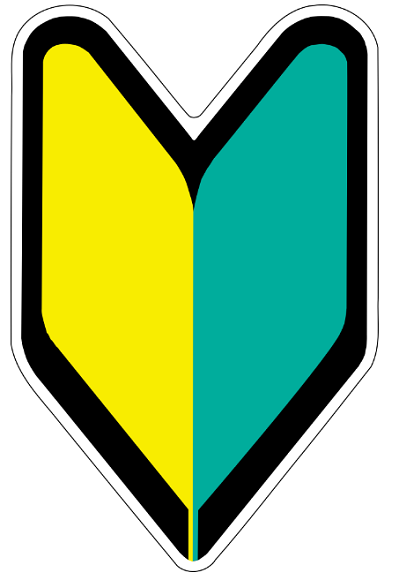Japan has a couple of unique automotive regulations. For example, every other year cars have to undergo an extensive inspection to make sure they’re being properly maintained and haven’t been illegally modified (although you can get away with some pretty interesting modifications in the 24 months between checks). You have to make a full stop at all railroad crossings, regardless of whether or not there’s a train coming.
For new drivers, there’s even an additional rule, which states that for their first year on the road, they have to put a large sticker on their car advising surrounding motorists to be extra careful. But while the law states the vehicle must bear two stickers, one on the front and one on the rear, there’s apparently no upper limit, as one proud owner recently demonstrated.
The stickers are called wakaba (“young leaf”) marks, and are patterned after a newly formed leaf in the vibrant colors of spring.
You most commonly find them along the front quarter panels and rear deck of the car.
The logic is that drivers with less experience are involved in more accidents, so the wakaba marks serve as a warning for others drivers to be especially cautious in their vicinity. The law’s the law, but, truth be told, a lot of people feel a little embarrassed about having to slap those stickers on their cars. For the owner of this Toyota Vitz, spotted by Twitter user Yamon, though, the wakaba mark seems to be a badge of pride, and he’s set out to slap as many as he can on his ride while still leaving enough space to arrange them in aesthetically pleasing patterns.
ガチ初心者や pic.twitter.com/WjWZhdTaWE
— やまん( ˙ω˙ )🤧 (@_yamanyaman) September 13, 2014
Internet users were similarly amused by the enthusiastic display.
“Beautiful.”
“Beginner-level itasha.”
“Beginner-level driver, master-level wakaba mark artist.”
“Man, I should have done this when I had to have them on my car!”
Silly as it may be, in the end this rolling artistic expression is still faithful to the intend purpose of the badges. “Yeah, I’d totally give this car a wide berth,” admitted one Internet commenter, which is exactly the effect the wakaba mark is designed to produce.
Source: Hamster Sokuho, Twitter
Insert images: Wikipedia/Chris Ruvolo


 Autonomous beverage and snack car now testing in Chiba City
Autonomous beverage and snack car now testing in Chiba City From bad to worse: Japanese driver hits car, sends it flying into Ferrari/Lamborghini showroom
From bad to worse: Japanese driver hits car, sends it flying into Ferrari/Lamborghini showroom Tokyo may soon require bicyclists to strap on a helmet before getting on the road
Tokyo may soon require bicyclists to strap on a helmet before getting on the road Neko motorcycle helmets featuring cute cat designs are purr-fect for cosplay and for the road
Neko motorcycle helmets featuring cute cat designs are purr-fect for cosplay and for the road Toyota’s new Mark X car paints a picture that depicts its Japanese roots【Video】
Toyota’s new Mark X car paints a picture that depicts its Japanese roots【Video】 Foreigner’s request for help in Tokyo makes us sad for the state of society
Foreigner’s request for help in Tokyo makes us sad for the state of society McDonald’s new Happy Meals offer up cute and practical Sanrio lifestyle goods
McDonald’s new Happy Meals offer up cute and practical Sanrio lifestyle goods Japanese city loses residents’ personal data, which was on paper being transported on a windy day
Japanese city loses residents’ personal data, which was on paper being transported on a windy day Anime girl English teacher Ellen-sensei becomes VTuber/VVTUber and NFT
Anime girl English teacher Ellen-sensei becomes VTuber/VVTUber and NFT Red light district sushi restaurant in Tokyo shows us just how wrong we were about it
Red light district sushi restaurant in Tokyo shows us just how wrong we were about it Harajuku Station’s beautiful old wooden building is set to return, with a new complex around it
Harajuku Station’s beautiful old wooden building is set to return, with a new complex around it Akihabara pop-up shop sells goods made by Japanese prison inmates
Akihabara pop-up shop sells goods made by Japanese prison inmates Japan’s massive matcha parfait weighs 6 kilos, contains hidden surprises for anyone who eats it
Japan’s massive matcha parfait weighs 6 kilos, contains hidden surprises for anyone who eats it Want to wear a student uniform to Tokyo Disneyland? Uniform rental shop opens just outside park
Want to wear a student uniform to Tokyo Disneyland? Uniform rental shop opens just outside park New private rooms on Tokaido Shinkansen change the way we travel from Tokyo to Kyoto
New private rooms on Tokaido Shinkansen change the way we travel from Tokyo to Kyoto Japanese ramen restaurants under pressure from new yen banknotes
Japanese ramen restaurants under pressure from new yen banknotes All-you-can-drink Starbucks and amazing views part of Tokyo’s new 170 meter-high sky lounge
All-you-can-drink Starbucks and amazing views part of Tokyo’s new 170 meter-high sky lounge French Fries Bread in Tokyo’s Shibuya becomes a hit on social media
French Fries Bread in Tokyo’s Shibuya becomes a hit on social media Studio Ghibli releases new action figures featuring Nausicaä of the Valley of the Wind characters
Studio Ghibli releases new action figures featuring Nausicaä of the Valley of the Wind characters Studio Ghibli glasses cases let anime characters keep an eye on your spectacles
Studio Ghibli glasses cases let anime characters keep an eye on your spectacles Tokyo Tsukiji fish market site to be redeveloped with 50,000-seat stadium, hotel, shopping center
Tokyo Tsukiji fish market site to be redeveloped with 50,000-seat stadium, hotel, shopping center Beautiful Ghibli sealing wax kits let you create accessories and elegant letter decorations【Pics】
Beautiful Ghibli sealing wax kits let you create accessories and elegant letter decorations【Pics】 Studio Ghibli releases Kiki’s Delivery Service chocolate cake pouches in Japan
Studio Ghibli releases Kiki’s Delivery Service chocolate cake pouches in Japan New definition of “Japanese whiskey” goes into effect to prevent fakes from fooling overseas buyers
New definition of “Japanese whiskey” goes into effect to prevent fakes from fooling overseas buyers Our Japanese reporter visits Costco in the U.S., finds super American and very Japanese things
Our Japanese reporter visits Costco in the U.S., finds super American and very Japanese things Studio Ghibli unveils Mother’s Day gift set that captures the love in My Neighbour Totoro
Studio Ghibli unveils Mother’s Day gift set that captures the love in My Neighbour Totoro New Japanese KitKat flavour stars Sanrio characters, including Hello Kitty
New Japanese KitKat flavour stars Sanrio characters, including Hello Kitty More foreign tourists than ever before in history visited Japan last month
More foreign tourists than ever before in history visited Japan last month New Pokémon cakes let you eat your way through Pikachu and all the Eevee evolutions
New Pokémon cakes let you eat your way through Pikachu and all the Eevee evolutions Sales of Japan’s most convenient train ticket/shopping payment cards suspended indefinitely
Sales of Japan’s most convenient train ticket/shopping payment cards suspended indefinitely Sold-out Studio Ghibli desktop humidifiers are back so Totoro can help you through the dry season
Sold-out Studio Ghibli desktop humidifiers are back so Totoro can help you through the dry season Japanese government to make first change to romanization spelling rules since the 1950s
Japanese government to make first change to romanization spelling rules since the 1950s Ghibli founders Toshio Suzuki and Hayao Miyazaki contribute to Japanese whisky Totoro label design
Ghibli founders Toshio Suzuki and Hayao Miyazaki contribute to Japanese whisky Totoro label design Doraemon found buried at sea as scene from 1993 anime becomes real life【Photos】
Doraemon found buried at sea as scene from 1993 anime becomes real life【Photos】 Tokyo’s most famous Starbucks is closed
Tokyo’s most famous Starbucks is closed One Piece characters’ nationalities revealed, but fans have mixed opinions
One Piece characters’ nationalities revealed, but fans have mixed opinions We asked a Uniqlo employee what four things we should buy and their suggestions didn’t disappoint
We asked a Uniqlo employee what four things we should buy and their suggestions didn’t disappoint Princesses, fruits, and blacksmiths: Study reveals the 30 most unusual family names in Japan
Princesses, fruits, and blacksmiths: Study reveals the 30 most unusual family names in Japan The most fun I’ve had behind the wheel this year was with Toyota’s unusual vision for the future of mobility
The most fun I’ve had behind the wheel this year was with Toyota’s unusual vision for the future of mobility Every weekend is an itasha car show at Akihabara’s UDX parking garage
Every weekend is an itasha car show at Akihabara’s UDX parking garage The clever way Japanese drivers thank each other without saying a word【Video】
The clever way Japanese drivers thank each other without saying a word【Video】 Truck driver hailed as “hero” for cutting off car on wet highway
Truck driver hailed as “hero” for cutting off car on wet highway Toyota to begin testing Guardian Angel—an invisible driving companion that could save your life
Toyota to begin testing Guardian Angel—an invisible driving companion that could save your life Fueled by road rage, two public transport buses in China collide【Video】
Fueled by road rage, two public transport buses in China collide【Video】 The best cosplayers from Day One of the Ikebukuro Halloween Cosplay Festival 2023
The best cosplayers from Day One of the Ikebukuro Halloween Cosplay Festival 2023 No mask, no ride – Japanese government allows taxis to refuse to pick up maskless passengers
No mask, no ride – Japanese government allows taxis to refuse to pick up maskless passengers Driver who killed cyclist in crosswalk accident found not guilty, causes controversy in Japan
Driver who killed cyclist in crosswalk accident found not guilty, causes controversy in Japan MariCar Mario Kart driver mounts pavement, causes serious damage in Tokyo accident
MariCar Mario Kart driver mounts pavement, causes serious damage in Tokyo accident Major Japanese ramen chain’s logo confuses Honda cars’ AI
Major Japanese ramen chain’s logo confuses Honda cars’ AI Toyota’s official anime itasha car finds a home
Toyota’s official anime itasha car finds a home Driver struck by another vehicle in the wrong lane, still ordered to pay 40 million yen
Driver struck by another vehicle in the wrong lane, still ordered to pay 40 million yen These “star marks” on the road in Japan that indicate when to use your blinker are amazing【Video】
These “star marks” on the road in Japan that indicate when to use your blinker are amazing【Video】 Car crashes into Hiroshima 7-Eleven, owner gets guard rails, car crashes into gap in the rails
Car crashes into Hiroshima 7-Eleven, owner gets guard rails, car crashes into gap in the rails Samsung prototype ‘Safety Truck’ uses all-weather screens to make driving safer, maybe
Samsung prototype ‘Safety Truck’ uses all-weather screens to make driving safer, maybe
Leave a Reply